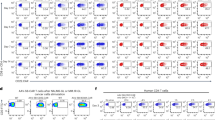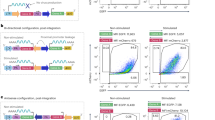Abstract
Fas ligand (FasL) is a member of the tumor necrosis family and when bound to its receptor, Fas, induces apoptosis. It plays important roles in immune response, degenerative and lymphoproliferative diseases, development and tumorigenesis. It is also involved in generation of immune privilege sites in the eye and testis. Harnessing the power of this molecule is expected to lead to a powerful chemotherapeutic. We describe the construction and characterization of replication-deficient adenoviral vectors that express a fusion of murine FasL and green fluorescent protein (GFP). FasL-GFP retains full activity of wild-type FasL, at the same time allowing for easy visualization and quantification in both living and fixed cells. The fusion protein is under the control of a tetracycline-regulated gene expression system. Tight control of expression is achieved by creating a novel ‘double recombinant’ Ad vector, in which the tet-responsive element and the transactivator element are built into the opposite ends of the same vector to avoid enhancer interference. Expression can be conveniently regulated by tetracycline or its derivatives in a dose-dependent manner. The vector was able to deliver FasL-GFP gene to cells in vitro efficiently, and the expression level and function of the fusion protein was modulated by the concentration of doxycycline. This regulation allows us to produce high titers of the vector by inhibiting FasL expression in an apoptosis-resistant cell line. Induction of apoptosis was demonstrated in all cell lines tested. These results indicate that our vector is a potentially valuable tool for FasL-based gene therapy of cancer and for the study of FasL/Fas-mediated apoptosis and immune privilege.
This is a preview of subscription content, access via your institution
Access options
Subscribe to this journal
Receive 12 print issues and online access
$259.00 per year
only $21.58 per issue
Buy this article
- Purchase on Springer Link
- Instant access to full article PDF
Prices may be subject to local taxes which are calculated during checkout








Similar content being viewed by others
References
Takahashi T et al. Human Fas ligand: gene structure, chromosomal location and species specificity Int Immunol 1994 6: 1567–1574
Bajorath J, Aruffo A . Prediction of the three-dimensional structure of the human Fas receptor by comparative molecular modeling J Comput Aided Mol Des 1997 11: 3–8
Watanabe-Fukunaga R et al. The cDNA structure, expression, and chromosomal assignment of the mouse Fas antigen J Immunol 1992 148: 1274–1279
Ogasawara J et al. Lethal effect of the anti-Fas antibody in mice (published erratum appears in Nature 1993 Oct 7; 365 (6446): 568) Nature 1993 364: 806–809
Nagata S, Golstein P . The Fas death factor Science 1995 267: 1449–1456
Larsen CP et al. Fas-mediated cytotoxicity. An immunoeffector or immunoregulatory pathway in T cell-mediated immune responses? Transplantation 1995 60: 221–224
Longthorne VL, Williams GT . Caspase activity is required for commitment to Fas-mediated apoptosis EMBO J 1997 16: 3805–3812
Watanabe-Fukunaga R et al. Lymphoproliferation disorder in mice explained by defects in Fas antigen that mediates apoptosis Nature 1992 356: 314–317
Golstein P . Fas-based T cell-mediated cytotoxicity Curr Top Microbiol Immunol 1995 198: 25–37
Berke G . The Fas-based mechanism of lymphocytotoxicity Hum Immunol 1997 54: 1–7
Tanaka M, Itai T, Adachi M, Nagata S . Downregulation of Fas ligand by shedding (see comments) Nature Med 1998 4: 31–36
Tanaka M, Suda T, Takahashi T, Nagata S . Expression of the functional soluble form of human fas ligand in activated lymphocytes EMBO J 1995 14: 1129–1135
Green DR, Ware CF . Fas-ligand: privilege and peril (see comments) Proc Natl Acad Sci USA 1997 94: 5986–5990
Griffith TS et al. Fas ligand-induced apoptosis as a mechanism of immune privilege (see comments) Science 1995 270: 1189–1192
Guller S . Role of Fas ligand in conferring immune privilege to non-lymphoid cells Ann NY Acad Sci 1997 828: 268–272
Hahne M et al. Melanoma cell expression of Fas(Apo-1/CD95) ligand: implications for tumor immune escape (see comments) Science 1996 274: 1363–1366
Strand S et al. Lymphocyte apoptosis induced by CD95 (APO-1/Fas) ligand-expressing tumor cells – a mechanism of immune evasion? (see comments) Nature Med 1996 2: 1361–1366
Saas P et al. Fas ligand expression by astrocytoma in vivo: maintaining immune privilege in the brain? J Clin Invest 1997 99: 1173–1178
Srinivasan A et al. Bcl-xL functions downstream of caspase-8 to inhibit Fas- and tumor necrosis factor receptor 1-induced apoptosis of MCF7 breast carcinoma cells J Biol Chem 1998 273: 4523–4529
Owen-Schaub LB et al. Soluble Fas/APO-1 in tumor cells: a potential regulator of apoptosis? Cancer Lett 1995 94: 1–8
Cascino I, Papoff G, Eramo A, Ruberti G . Soluble Fas/Apo-1 splicing variants and apoptosis Front Biosci 1996 1: d12–18
Judge TA et al. Utility of adenoviral-mediated Fas ligand gene transfer to modulate islet allograft survival Transplantation 1998 66: 426–434
Sata M et al. Fas ligand gene transfer to the vessel wall inhibits neointima formation and overrides the adenovirus-mediated T cell response Proc Natl Acad Sci USA 1998 95: 1213–1217
Swenson KM et al. Fas ligand gene transfer to renal allografts in rats: effects on allograft survival Transplantation 1998 65: 155–160
Zhang HG et al. Induction of specific T-cell tolerance by adenovirus-transfected, Fas ligand-producing antigen presenting cells (see comments) Nat Biotechnol 1998 16: 1045–1049
Zhang HG et al. Application of a Fas ligand encoding a recombinant adenovirus vector for prolongation of transgene expression J Virol 1998 72: 2483–2490
Arai H, Gordon D, Nabel EG, Nabel GJ . Gene transfer of Fas ligand induces tumor regression in vivo Proc Natl Acad Sci USA 1997 94: 13862–13867
Shiner M et al. Are intraepithelial lymphocytes in celiac mucosa responsible for inducing programmed cell death (apoptosis) in enterocytes? Histochemical demonstration of perforins in cytoplasmic granules of intraepithelial lymphocytes J Pediatr Gastroenterol Nutr 1998 27: 393–396
Gossen M, Bujard H . Tight control of gene expression in mammalian cells by tetracycline-responsive promoters Proc Natl Acad Sci USA 1992 89: 5547–5551
Muruve DA et al. Adenovirus-mediated expression of Fas ligand induces hepatic apoptosis after systemic administration and apoptosis of ex vivo-infected pancreatic islet allografts and isografts Hum Gene Ther 1997 8: 955–963
Harding TC et al. Switching transgene expression in the brain using an adenoviral tetracycline-regulatable system (see comments) Nat Biotechnol 1998 16: 553–555
Hearing P, Shenk T . The adenovirus type 5 E1A transcriptional control region contains a duplicated enhancer element Cell 1983 33: 695–703
Shi Q, Wang Y, Worton R . Modulation of the specificity and activity of a cellular promoter in an adenoviral vector Hum Gene Ther 1997 8: 403–410
Han J et al. The E1B 19K protein blocks apoptosis by interacting with and inhibiting the p53-inducible and death-promoting Bax protein Genes Dev 1996 10: 461–477
Larregina AT et al. FasL induces Fas/Apo1-mediated apoptosis in human embryonic kidney 293 cells routinely used to generate E1-deleted adenoviral vectors Gene Therapy 1998 5: 563–568
Tewari M, Dixit VM . Fas- and tumor necrosis factor-induced apoptosis is inhibited by the poxvirus crmA gene product J Biol Chem 1995 270: 3255–3260
Kang SM et al. Fas ligand expression in islets of Langerhans does not confer immune privilege and instead targets them for rapid destruction (see comments) Nature Med 1997 3: 738–743
Shinoura N et al. Apoptosis by retrovirus- and adenovirus-mediated gene transfer of Fas ligand to glioma cells: implications for gene therapy (in process citation) Hum Gene Ther 1998 9: 1983–1993
Kang SM, Lin Z, Ascher NL, Stock PG . Fas ligand expression on islets as well as multiple cell lines results in accelerated neutrophilic rejection Transplant Proc 1998 30: 538–543
Okuyama T et al. Efficient Fas-ligand gene expression in rodent liver after intravenous injection of a recombinant adenovirus by the use of a Cre-mediated switching system Gene Therapy 1998 5: 1047–1053
Tanaka M et al. Fas ligand in human serum Nature Med 1996 2: 317–322
Tewari M, Beidler DR, Dixit VM . CrmA-inhibitable cleavage of the 70-kDa protein component of the U1 small nuclear ribonucleoprotein during Fas- and tumor necrosis factor-induced apoptosis J Biol Chem 1995 270: 18738–18741
Moreno MB, Memon SA, Zacharchuk CM . Apoptosis signaling pathways in normal T cells: differential activity of Bcl-2 and IL-1beta-converting enzyme family protease inhibitors on glucocorticoid- and Fas-mediated cytotoxicity J Immunol 1996 157: 3845–3849
Memon SA, Moreno MB, Petrak D, Zacharchuk CM . Bcl-2 blocks glucocorticoid- but not Fas- or activation-induced apoptosis in a T cell hybridoma J Immunol 1995 155: 4644–4652
Zhang G, Gurtu V, Kain SR . An enhanced green fluorescent protein allows sensitive detection of gene transfer in mammalian cells Biochem Biophys Res Commun 1996 227: 707–711
Huang MM, Hearing P . The adenovirus early region 4 open reading frame 6/7 protein regulates the DNA binding activity of the cellular transcription factor, E2F, through a direct complex Genes Dev 1989 3: 1699–1710
Graham FL, Smiley J, Russell WC, Nairn R . Characteristics of a human cell line transformed by DNA from human adenovirus type 5 J Gen Virol 1977 36: 59–74
Acknowledgements
We wish to thank Dr James Norris (Department of Microbiology and Immunology, Medical University of South Carolina) for his advice and assistance in the preparation of this manuscript. This study was supported in part by Grants for American Cystic Fibrosis Foundation: DONG96PO, DONG97PO and Grants from NIH: DK46177 and DK53217.
Author information
Authors and Affiliations
Rights and permissions
About this article
Cite this article
Rubinchik, S., Ding, R., Qiu, A. et al. Adenoviral vector which delivers FasL–GFP fusion protein regulated by the tet-inducible expression system. Gene Ther 7, 875–885 (2000). https://doi.org/10.1038/sj.gt.3301172
Received:
Accepted:
Published:
Issue Date:
DOI: https://doi.org/10.1038/sj.gt.3301172
Keywords
This article is cited by
-
Novel system uses probasin-based promoter, transcriptional silencers and amplification loop to induce high-level prostate expression
BMC Biotechnology (2007)
-
The histone deacetylase inhibitors depsipeptide and MS-275, enhance TRAIL gene therapy of LNCaP prostate cancer cells without adverse effects in normal prostate epithelial cells
Cancer Gene Therapy (2007)
-
Combined therapeutic use of AdGFPFasL and small molecule inhibitors of ceramide metabolism in prostate and head and neck cancers: a status report
Cancer Gene Therapy (2006)
-
New complex Ad vectors incorporating both rtTA and tTS deliver tightly regulated transgene expression both in vitro and in vivo
Gene Therapy (2005)
-
Liver-specific expression of interferon γ following adenoviral gene transfer controls hepatitis B virus replication in mice
Gene Therapy (2005)



